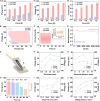Boosting Output Performance of Triboelectric Nanogenerator via Interface Self-Regulation Strategy
- PMID: 41020159
- PMCID: PMC12463547
- DOI: 10.34133/research.0906
Boosting Output Performance of Triboelectric Nanogenerator via Interface Self-Regulation Strategy
Abstract
The long-term durability of triboelectric nanogenerators (TENGs) remains a critical challenge for their practical deployment. Although approaches like reducing interfacial friction or contact duration can enhance durability, they often compromise electrical performance. The charge self-excitation method can improve the output performance. However, when it is introduced into the sliding mode with small capacitance change, it increases the complexity of the circuit and cannot solve the problem of charge attenuation caused by material wear. Herein, we propose a self-regulation strategy that concurrently controls the interface contact state and contact force. This approach synergistically combines the advantages of both sliding and contact-separation configurations, enabling the triboelectric materials to micro-slide and deform adaptively, ensuring stable dynamic interfacial contact under minimal normal pressure. Such a mechanism promotes strong electron cloud overlap at the microscale, thereby enhancing charge transfer efficiency. Compared to conventional TENGs, the self-regulating TENG achieves a 72.5-fold reduction in frictional force and a 13-fold increase in energy output. Furthermore, a wireless self-powered sensing system is integrated, achieving a power density of 242.4 mW/m2 under real water flow conditions. The system maintains 97.6% of the initial output after 10 h of continuous operation, confirming the practical feasibility of the proposed approach. This work presents a universal method to enhance the electrical performance and durability of TENGs, paving the way for their broader application.
Copyright © 2025 Yanrui Zhao et al.
Conflict of interest statement
Competing interests: The authors declare that they have no competing interests.
Figures





References
-
- Alagumalai A, Shou W, Mahian O, Aghbashlo M, Tabatabaei M, Wongwises S, Liu Y, Zhan J, Torralba A, Chen J, et al. Self-powered sensing systems with learning capability. Joule. 2022;6(7):1475–1500.
-
- Chu S, Majumdar A. Opportunities and challenges for a sustainable energy future. Nature. 2012;488:294–303. - PubMed
LinkOut - more resources
Full Text Sources

